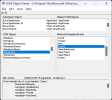carlos.valentini
New Member
Good morning to all of the forum.
I need a little help.
I have the following situation:
- An Excel spreadsheet, in which I should use the progress command, search for a certain string for example "& 1" and replace with another one.
How do I do that? Which VBA command can I use?
Does anyone have an example?
I need a little help.
I have the following situation:
- An Excel spreadsheet, in which I should use the progress command, search for a certain string for example "& 1" and replace with another one.
How do I do that? Which VBA command can I use?
Does anyone have an example?

